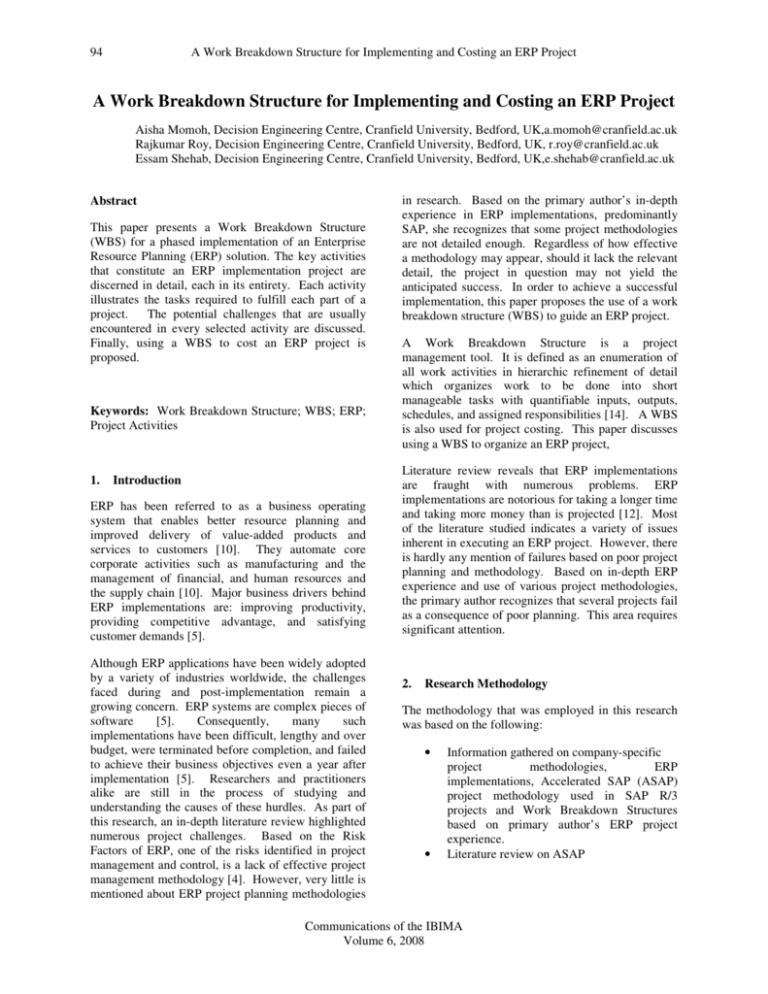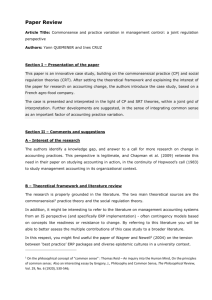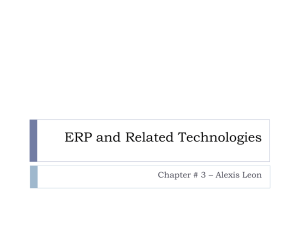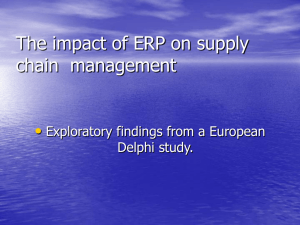
94
A Work Breakdown Structure for Implementing and Costing an ERP Project
A Work Breakdown Structure for Implementing and Costing an ERP Project
Aisha Momoh, Decision Engineering Centre, Cranfield University, Bedford, UK,a.momoh@cranfield.ac.uk
Rajkumar Roy, Decision Engineering Centre, Cranfield University, Bedford, UK, r.roy@cranfield.ac.uk
Essam Shehab, Decision Engineering Centre, Cranfield University, Bedford, UK,e.shehab@cranfield.ac.uk
Abstract
This paper presents a Work Breakdown Structure
(WBS) for a phased implementation of an Enterprise
Resource Planning (ERP) solution. The key activities
that constitute an ERP implementation project are
discerned in detail, each in its entirety. Each activity
illustrates the tasks required to fulfill each part of a
project.
The potential challenges that are usually
encountered in every selected activity are discussed.
Finally, using a WBS to cost an ERP project is
proposed.
Keywords: Work Breakdown Structure; WBS; ERP;
Project Activities
1.
Introduction
ERP has been referred to as a business operating
system that enables better resource planning and
improved delivery of value-added products and
services to customers [10]. They automate core
corporate activities such as manufacturing and the
management of financial, and human resources and
the supply chain [10]. Major business drivers behind
ERP implementations are: improving productivity,
providing competitive advantage, and satisfying
customer demands [5].
Although ERP applications have been widely adopted
by a variety of industries worldwide, the challenges
faced during and post-implementation remain a
growing concern. ERP systems are complex pieces of
software
[5].
Consequently,
many
such
implementations have been difficult, lengthy and over
budget, were terminated before completion, and failed
to achieve their business objectives even a year after
implementation [5]. Researchers and practitioners
alike are still in the process of studying and
understanding the causes of these hurdles. As part of
this research, an in-depth literature review highlighted
numerous project challenges. Based on the Risk
Factors of ERP, one of the risks identified in project
management and control, is a lack of effective project
management methodology [4]. However, very little is
mentioned about ERP project planning methodologies
in research. Based on the primary author’s in-depth
experience in ERP implementations, predominantly
SAP, she recognizes that some project methodologies
are not detailed enough. Regardless of how effective
a methodology may appear, should it lack the relevant
detail, the project in question may not yield the
anticipated success. In order to achieve a successful
implementation, this paper proposes the use of a work
breakdown structure (WBS) to guide an ERP project.
A Work Breakdown Structure is a project
management tool. It is defined as an enumeration of
all work activities in hierarchic refinement of detail
which organizes work to be done into short
manageable tasks with quantifiable inputs, outputs,
schedules, and assigned responsibilities [14]. A WBS
is also used for project costing. This paper discusses
using a WBS to organize an ERP project,
Literature review reveals that ERP implementations
are fraught with numerous problems. ERP
implementations are notorious for taking a longer time
and taking more money than is projected [12]. Most
of the literature studied indicates a variety of issues
inherent in executing an ERP project. However, there
is hardly any mention of failures based on poor project
planning and methodology. Based on in-depth ERP
experience and use of various project methodologies,
the primary author recognizes that several projects fail
as a consequence of poor planning. This area requires
significant attention.
2.
Research Methodology
The methodology that was employed in this research
was based on the following:
•
•
Information gathered on company-specific
project
methodologies,
ERP
implementations, Accelerated SAP (ASAP)
project methodology used in SAP R/3
projects and Work Breakdown Structures
based on primary author’s ERP project
experience.
Literature review on ASAP
Communications of the IBIMA
Volume 6, 2008
Aisha Momoh,Rajkumar Roy and Essam Shehab
•
•
•
3.
Identifying project activities that are
excluded from ASAP based on knowledge of
company-specific project methodologies.
Using a WBS to amalgamate the identified
project activities with the ASAP project
activities
Based on literature review of ERP challenges
and previous case study, identifying
challenges associated with each project
activity in the WBS.
•
•
ASAP Project Methodology
SAP introduced the ASAP implementation
methodology with the goal of speeding up SAP
implementation
projects
[9].
ASAP
implementation is a structured implementation
approach that can help managers achieve a faster
implementation with quicker user acceptance,
well-defined
roadmaps,
and
efficient
documentation at various phases [9]. The ASAP
methodology phases are [9]:
•
•
•
Project preparation – the purpose of this
phase is to provide initial planning and
preparation of the SAP project. The steps of
this phase help identify and plan the primary
focus areas to be considered such as:
objectives, scope, plan and definition of
project team. The outcome is the project
charter.
Business blueprint – the purpose of this
phase is to create the business blueprint,
which is a detailed documentation of the
organizational structure and business
processes gathered during requirements
workshops/meetings.
It will allow the
implementation project team to clearly define
their scope, and only focus on the SAP
processes needed to run the organization
business.
Realisation – the purpose of this phase is to
actually configure SAP R/3 based on the
specifications of the business blueprint as
well as taking further input into account
(Questions and Answer database).
The
objective is the final configuration of the
95
system, an overall test, and the release of the
system for live operation.
Final preparation – the purpose of this
phase is to complete the final preparation,
including testing, end user training, system
management and cutover activities. The final
preparation phase also serves to resolve all
open issues.
Go live and support – the purpose of this
phase is to move from a pre-production
environment to live operation. A support
organization must be set up for end users to
provide long-term support. This phase is also
used to monitor system transactions and to
improve overall system performance.
Finally, the completed project is closed.
Each phase is composed of a group of work packages
[9]. These work packages are structured in activities,
and each activity is composed of a group of tasks [9].
For each task, a definition, a set of procedures, results
and roles are provided in the ASAP methodology
documentation [9]. Implementations where ASAP or
Powered by SAP methodologies were used averaged
only 8 months, compared to 15 months for standard
implementations [9].
4.
Work Breakdown
Implementation
Structure
for
ERP
A complex project is made manageable by first
breaking it into individual components in a
hierarchical structure, known as Work Breakdown
Structure [13]. Such a structure defines tasks that can
be completed independently of other tasks, facilitating
resource allocation, assignment of responsibilities, and
measurement and control of the project [13].
This section depicts the use of a WBS in Figures 1, 1a
and 1b to plan an ERP project. The various levels in
the WBS are illustrated in Table 1.
Communications of the IBIMA
Volume 6, 2008
96
A Work Breakdown Structure for Implementing and Costing an ERP Project
Fig 1. WBS for ERP Implementation
Communications of the IBIMA
Volume 6, 2008
Aisha Momoh,Rajkumar Roy and Essam Shehab
Fig 1a. WBS for ERP Implementation
Communications of the IBIMA
Volume 6, 2008
97
98
A Work Breakdown Structure for Implementing and Costing an ERP Project
Fig 1b. WBS for ERP Implementation
Table 1 below illustrates the various levels of project
activity in the WBS structures above.
Each
organization uses its own terminology for classifying
WBS components according to their level in the
hierarchy [13]. For example, some organizations refer
to different levels as tasks, sub-tasks and work
packages, whilst others use the terms phases, entries
and activities [13]. In this paper, activities are used to
classify the WBS components. The nodes (in circles)
A and B indicate continuation of the activities linked
to these nodes
Table 1: WBS Component Levels
Project
ERP
Implementation
First Level
Activity
Project Preparation
System
Architecture
Design
Business Blueprint
Second Level Activity
Define Project Scope and
Objectives
Identify Project Team
Identify Stakeholders
Identify System Environment
AS-IS Business Process
Analysis
Map ERP Processes to
Business Processes
Communications of the IBIMA
Volume 6, 2008
Third Level Activity
Technical Infrastructure
Preparation
Identify Development
Environment
Identify Quality
Assurance Environment
Identify Training
Environment
Identify Production
Environment
Identify End-to-End
Current Business
Processes
Identify Process
Integration Points
Aisha Momoh,Rajkumar Roy and Essam Shehab
Project
First Level
Activity
Second Level Activity
Third Level Activity
Define TO-BE Processes
Define End-to-End
Future Business
Processes
Identify Gaps
Propose Gap Solution
Configuration and
Development
Document Blueprint
Sign Off Blueprint
Configure Solution
Develop Code for Identified
Gaps
Define
Authorizations
Data Conversion
Data Migration
Program
Development
System Testing
Training
Sign Off Configuration and
Development
Define Roles in Organisation
Identify Roles for Use of
ERP
Define Authorisations
Test Authorisations
Sign Off Authorisations
Define Fields in ERP
Solution
Map ERP Fields to Legacy
System Fields
Convert Legacy Fields to
ERP Fields
Define Data for Cleansing
Cleanse Data
Sign Off Data Cleansing
Develop Migration Program
Unit Test Migration Program
Sign Off Data Migration
Program
Define Test Scripts
Test ERP Solution End-toEnd
Sign Off System Tests
Define Business Processes
Based on Roles
Communications of the IBIMA
Volume 6, 2008
Define Reports
Define Programs
Define Interfaces
Define Manual
Processes
Write Unit Test Scripts
Configure Solution
Unit test Configuration
Write Technical
Specifications
Write Unit Test Scripts
Unit Test
Programs/Reports/Interf
aces
99
100
A Work Breakdown Structure for Implementing and Costing an ERP Project
Project
First Level
Activity
User Acceptance
Testing
Cutover
5.
Second Level Activity
Third Level Activity
Document Training
Train Users on Business
Processes
Train Users on ERP
Define Business Scenarios
User Acceptance Test
Documents
Define User Acceptance Test
Scripts
Test ERP functionality
Sign Off
Migrate Cleansed Data
Go Live
WBS Activities and Potential Challenges
The WBS project activities in table 1 will be described
in this section. They have been derived from the
ASAP project methodology, literature review on
project methodologies and SAP implementation
experience.
Certain activities that are already
embedded as sub-tasks in ASAP project activities are
illustrated as First Level activities for transparency
and more effective planning. Such activities are
System Architecture Design, Define
Create Fault Report
Sheet
team is not responsible for the technical infrastructure,
it is essential that it is flagged in the WBS as a
dependency.
Potential challenges in this activity are: (i)
unavailability of technical infrastructure, (ii)
technology complexity[4], (iii) failure in attempt to
link legacy applications, (iv) and minimal
understanding of architecture requirements and
design.
Business Blueprint
Authorizations, Data Conversion, Data Migration
Program Development, System Testing, Training, and
User Acceptance Testing. First Level activities will be
the focus of this section as well as the potential
challenges that could emerge during the execution of
each activity.
Project Preparation
This activity has been defined in section 4 of this
paper. Some of the challenges that may present
themselves in project management and control, which
is part of project preparation, are: (i) lack of
agreement on project goals, (ii) lack of senior
management involvement, and (iii) a lack of effective
project management methodology [4].
System Architecture Design
The essence of this activity is to agree on and define
the environment upon which the ERP application will
be installed. At this stage, the environments in which
the application will be configured, quality assured and
operate in a live situation are also critical
considerations. Furthermore, even though the project
This activity has been described in section 4 of this
paper. Some of the likely potential challenges during
the execution of this activity are: (i) minimal
understanding of business processes, (ii) business
requirements to customize the ERP application
beyond its standard functionality, (iii) lack of business
process reengineering, (iv) employee resistance to
change, (v) use of inexperienced consultants, and (vi)
minimal understanding of the ERP application
functionality. Further challenges are being unable to
comply with the standard which ERP software
supports, and a lack of integration between enterprisewide systems [4].
Configuration and Development
This activity is equivalent to the Realisation part of
the ASAP methodology. It involves configuring the
ERP application based on the business blueprint. It is
essential the application is configured using to the
standard functionality in the system. Other activities
under the umbrella of this main activity are the
development of reports, interfaces and additional
programs.
Communications of the IBIMA
Volume 6, 2008
Aisha Momoh,Rajkumar Roy and Essam Shehab
Some of the likely challenges in this activity are: (i)
unclear and misunderstanding of changes in
requirements, (ii) lack of an effective methodology,
and (iii) poor estimation and failure to perform the
activities needed [4].
Customization is usually
associated with increased IS costs, longer
implementation time, and the inability to benefit from
vendor software maintenance, and upgrades [5].
Another key challenge is a lack of understanding of
the ERP application by the consultants. Additionally,
lack of resources represents a major concern in ERP
implementation [5].
Define Authorizations
101
The type of challenges that may be faced during
system testing are: (i) discovering that a substantial
amount of the configured functionality does not meet
business requirements, (ii) allowing scope creep due
to sudden changes, (iii) the tendency to carry on
testing beyond its specified, and (iv) lack of
understanding of the ERP application.
Training
Training involves imparting knowledge of the
implemented solution to the users before the system
goes into live operation. This activity entails defining
business processes for the respective roles and
defining business scenarios to suit these processes.
These scenarios enable the users to understand the
system functionality better.
The purpose of this activity is to define the roles of the
respective ERP application users once the application
has gone live. These roles will be used to define
access rights for each of the users. This way,
unauthorized users will not be allowed access to
information in the ERP application that is not within
their jurisdiction. The main challenge in this activity
is incorrect definition of roles and authorizations.
Insufficient training of end users could be a potential
challenge during the Training exercise [4]. Other
potential challenges are: (i) lack of user commitment
and ineffective communication with users, and (ii)
conflicts between user departments [4].
Data Conversion
User Acceptance Testing (UAT)
This activity involves converting the format of the
data in the legacy system to suit the data format of the
ERP system. This process also entails cleansing the
data in the legacy system. This means that the users
will filter through the data in their old system, and
eradicate any discrepancies.
This activity involves the users whom will utilize the
ERP application in a live environment, ensuring that
all the business requirements are met in the system
and are functional.
The users define business
scenarios for testing.
A fundamental requirement for the effectiveness of
ERP system is the availability and timeliness of
accurate data [5]. They further advise that the
management of data entering the system is a critical
issue throughout system implementation. Data-related
challenges include finding the proper data to load into
the system and converting disparate data structures
into a single, consistent format before system use [5].
Data Migration Program Development
The Data Migration Program Development activity
involves coding the program that will transfer the data
from the legacy system to the ERP application.
Potential challenges that could be presented during the
execution of this activity are: (i) lack of coding skills,
and (ii) improperly defined data.
System Testing
Potential challenges in UAT are: (i) lack of user
training, (ii) lack of understanding of the business
processes and requirements, and (iii) resistance to
change.
Cutover
This activity means going live by migrating from the
legacy system to the ERP application.
This
application becomes operational in a live
environment. It involves migrating live data from the
legacy system to the new system.
Typical challenges that may be presented whilst
executing this activity are: (i) unavailability of a
complete set of data for migration, (ii) failure of data
migration program, (iii) unavailability of operational
environment for data to be migrated into, and (iv) lack
of business readiness.
6.
System Testing entails the consultants that
implemented the ERP application ensuring that the
system works end-to-end. The entire system is tested,
process by process across all functions of the system.
Discussions and Conclusion
Researchers and practitioners concede that ERP
implementations are fraught with problems.
Literature review reaffirms this fact, and illustrates a
Communications of the IBIMA
Volume 6, 2008
102
A Work Breakdown Structure for Implementing and Costing an ERP Project
variety of ERP implementation challenges. However,
not much is mentioned about poor project planning
being one of the challenges encountered in ERP
project execution. The methodologies used in project
planning and the way that they are used go a long way
in determining the success or failure of a project.
A good project methodology known as ASAP, which
is used in SAP implementations, was studied.
However, in order to ensure that all aspects of an ERP
implementation are addressed, it is advisable to extend
ASAP and other methodologies into a WBS. The
WBS will be used to define the ERP project activities
so that the lowest level of activity is accounted for.
This paper illustrated the use of a WBS in defining
project activities. Additionally, based on a previous
case study and literature review, the challenges that
likely to be encountered in ERP implementations were
highlighted. Going forward, further research should
be conducted to link these challenges to the WBS
using a Risk Breakdown Structure (RBS). This
exercise will guide an organization implementing ERP
against the potential risks that are likely in project
activities.
A further area for research is the costing of ERP
project activities using a WBS. This will guide
organizations in preparing realistic budgets for their
ERP implementations.
7.
References
[1] Kovacs, G.L., Paganelli, P. “A Planning and
Management Infrastructure for Lare, Complex,
Distributed Projects – Beyond ERP and SCM”,
Computers in Industry (51), 2003, pp. 165-183.
[2] Wei, C., Wang, M.J. “A Comprehensive
Framework for Selecting an ERP System”,
International Journal of Project Management (22),
2004, pp. 161-169.
[3] Labuschagne, C., Brent, A.C. “Sustainable Project
Life Cycle Management: the Need to Integrate Life
Cycles in the Manufacturing Sector”, International
Journal of Project Management (23), 2005, pp. 159168.
[4] Huang, S., Chang, I., Li, S., Lin, M. “Assessing
Risk in ERP Projects: Identify and Prioritize the
Factors”, Industrial Management & Data Systems
(104:8), 2004, pp. 681-688.
[5] Somers, T.M., Nelson, K.G. “A Taxonomy of
Players and Activities Across the ERP Project Life
Cycle”, Information and Management (41), 2004, pp.
257-278.
[6] Daneva, M. @Lessons Learnt from Five Years of
Experience in ERP Requirements Engineering”,
Proceedings of the 11th IEEE International
Requirements Engineering Conference, 2003.
[7] Gable, G.G., Scott, J.E., Davenport, T.D.
“Cooperative
ERP
Life-Cycle
Knowledge
Management”, Proceedings of the Ninth Australian
Conference on Information Systems, September –
October 1998, pp. 227-240.
[8] Leopoulos, V., Kirytopoulos, K., Voulgaridou, D.
“ERP Systems as a Component of the Electronic
Supply Chain: Classification of Implementation
Risks”, Proceedings of the 2005 International
Conference on computational Intelligence for
Modelling, Control and Automation, and International
Confe Intelligent Agents, Web Technologies and
Internet Commerce, 2005.
[9] Esteves, J., Chan, R., Pastor, J., Rosemann, M.
“An Exploratory Study of Knowledge Types
Relevance Along Enterprise Systems Implementation
Phases”, 4th European Conference on Organizational
Knowledge and Learning Capabilities, April 2003.
[10] Chang, S. “ERP Life Cycle Implementation,
Management and Support: Implications for Practice
and Research”, Proceedings of the 37th Hawaii
International Conference on System Sciences, 2004.
[11] Esteves, J., Pastor, J.A. “A Framework to
Analyse Most Critical Work Packages in ERP
Implementation Projects”, International Conference
on Enterprise Information Systems, 2002.
[12] Mabert, V.A., Soni, A., Venkataramanan, M.A.
“Enterprise resource planning survey of US
manufacturing firms”, Production and Inventory
Management Journal (41:2), 2000, pp. 52-58.
[13] Work Breakdown Structure.
Retrieved June 7, 2008,
from:
//www.netmba.com/operations/project/wbs/
[14] Tausworthe, R.C. The Work Breakdown
Structure in Software Project Management.
Retrieved June 8, 2008,
from://md1.csa.com/partners/viewrecord.php?requeste
r=gs&collection=TRD&recid=A8133550AH&q=Wor
k+Breakdown+Structure+Tausworthe&uid=79289263
1&setcookie=yes
Communications of the IBIMA
Volume 6, 2008
Aisha Momoh,Rajkumar Roy and Essam Shehab
Copyright © 2008 by the International Business
Information Management Association (IBIMA). All
rights reserved. Authors retain copyright for their
manuscripts and provide this journal with a
publication permission agreement as a part of IBIMA
copyright agreement. IBIMA may not necessarily
agree with the content of the manuscript. The content
and proofreading of this manuscript as well as and any
errors are the sole responsibility of its author(s). No
part or all of this work should be copied or reproduced
in digital, hard, or any other format for commercial
use without written permission. To purchase reprints
of this article please e-mail: admin@ibima.org.
Communications of the IBIMA
Volume 6, 2008
103









